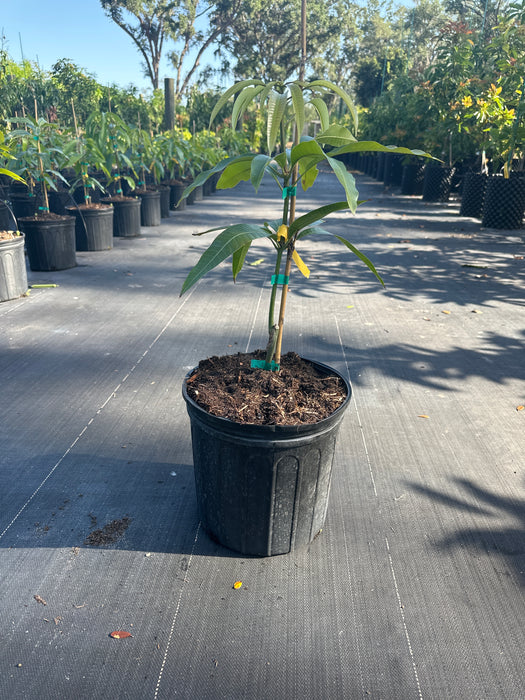
Mango-Cat Saigon Tree
-
Taste
-
The Cat Saigon Mango is highly praised for its exceptionally sweet, rich, and aromatic flavor.
-
The flesh is fiberless, smooth, and juicy, making it ideal for fresh eating, smoothies, and desserts.
-
It has a distinct tropical fragrance and a hint of spice that sets it apart from common commercial varieties.
-
When ripe, the fruit develops a golden yellow color with a creamy texture that practically melts in your mouth.
-
-
Best Growing Environment
-
The Cat Saigon Mango thrives in warm, humid, tropical to subtropical climates with plenty of sunshine.
-
It performs best when planted in well-draining sandy or loamy soil with slightly acidic to neutral pH (6.0–7.0).
-
It should be placed in a protected location if grown in areas with occasional cold snaps or strong winds.
-
Coastal or inland areas in USDA Zones 9b–11 are ideal for optimal growth and fruit production.
-
-
Botanical Name
-
Mangifera indica ‘Cat Saigon’
-
-
Common Names
-
Cat Saigon Mango
-
Vietnamese Mango
-
-
Average Height
-
Typically grows to 15–25 feet when planted in the ground
-
Can be kept smaller (8–12 feet) with annual pruning for easier maintenance and harvesting
-
-
Growth Rate
-
Moderate to fast growth rate under optimal tropical and subtropical conditions
-
Can grow up to 2–4 feet per year when young
-
-
Sun Requirements
-
Requires full sun (at least 6–8 hours of direct sunlight daily) for best fruiting
-
Will tolerate partial sun but with reduced yield and slower growth
-
-
Cold Hardiness
-
Cold hardy down to about 30°F once mature
-
Young trees should be protected when temperatures dip below 35°F
-
Not suitable for areas with prolonged frost or freezes without protection
-
-
Water Requirements
-
Moderate water needs—deep watering once or twice weekly during dry spells
-
Keep soil moist but never soggy; allow top few inches to dry between watering
-
Reduce watering in winter when growth slows
-
-
Planting Guide
-
Plant in spring or early summer to establish before cooler temperatures
-
Choose a sunny location with excellent drainage
-
Dig a hole twice as wide and as deep as the root ball
-
Mix in organic compost and mound soil slightly to avoid water pooling at the base
-
Space trees at least 10–15 feet apart from other plants or structures
-
Mulch around the base with 2–4 inches of organic mulch, keeping it a few inches from the trunk
-
-
Detailed Times of Year to Fertilize with Specific Recommended Fertilizer
-
Spring (March–April): Apply a high-nitrogen fertilizer such as 8-3-9 or 10-10-10 to promote vegetative growth
-
Early Summer (June): Use a balanced fertilizer like 8-3-9 again, including micronutrients like magnesium and manganese
-
Late Summer (August): Apply a low-nitrogen fertilizer like 0-0-20 or 4-6-8 to help encourage flower bud development
-
Fall (October): Use a light application of potassium-rich fertilizer (0-0-22) if trees are still growing actively
-
Avoid fertilizing during winter (November–February) to prevent stimulating tender growth during cold months
-
-
USDA Zone
-
Grows best in USDA Zones 9b–11
-
May require cold protection or container growth in Zone 9a
-

